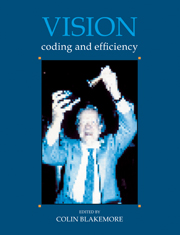Book contents
- Frontmatter
- Contents
- List of Contributors
- Preface
- Reply
- Acknowledgements
- Concepts of coding and efficiency
- Efficiency of the visual pathway
- Colour
- 11 The two subsystems of colour vision and their rôles in wavelength discrimination
- 12 The effect of the angle of retinal incidence on the color of monochromatic light
- 13 Fourier Interferometric Stimulation (FIS): the method and its applications
- 14 The chromatic coding of space
- Brightness, adaptation and contrast
- Development of vision
- Depth and texture
- Motion
- From image to object
- Index
11 - The two subsystems of colour vision and their rôles in wavelength discrimination
Published online by Cambridge University Press: 05 May 2010
- Frontmatter
- Contents
- List of Contributors
- Preface
- Reply
- Acknowledgements
- Concepts of coding and efficiency
- Efficiency of the visual pathway
- Colour
- 11 The two subsystems of colour vision and their rôles in wavelength discrimination
- 12 The effect of the angle of retinal incidence on the color of monochromatic light
- 13 Fourier Interferometric Stimulation (FIS): the method and its applications
- 14 The chromatic coding of space
- Brightness, adaptation and contrast
- Development of vision
- Depth and texture
- Motion
- From image to object
- Index
Summary
Introduction
Horace Barlow makes only occasional forays into the field of colour vision (Barlow, 1958,1982), but when he does, he always leaves us with much to think about. In his 1982 paper ‘What causes trichromacy?’, he gave us a novel way of considering the information content of a coloured spectrum: he expressed the detailed structure of the colour spectrum in terms of its Fourier components and he treated the three photopigments (Fig. 11.1) as low-pass filters that would differentially attenuate the different Fourier components. Owing to the broad bandwidth of the filters, the visual system is insensitive to the fine structure of the colour spectrum; that is to say, if the amplitude of a stimulus varies periodically with wavelength and if the period of this modulation is small, then the response of the visual system will show little variation as the phase of the modulation is changed (Barlow, 1982).
In considering his main question – that of why our colour vision is three-dimensional – Barlow was led also to ask several secondary questions: ‘Why do the photopigments have such broad bandwidths?’, ‘Are broad bandwidths deleterious to hue discrimination?’ and ‘Why are the peak sensitivities of the pigments so asymmetrically placed in the spectrum?’ We hope that the present paper may say something in answer to these secondary questions. We first put forward a general view of the early stages of colour vision, the view that it consists of two subsystems, one recently overlaid on a much earlier one; and then we review some experimental work on wavelength discrimination, work that bears on the two subsystems of colour vision.
- Type
- Chapter
- Information
- VisionCoding and Efficiency, pp. 119 - 131Publisher: Cambridge University PressPrint publication year: 1991
- 2
- Cited by



